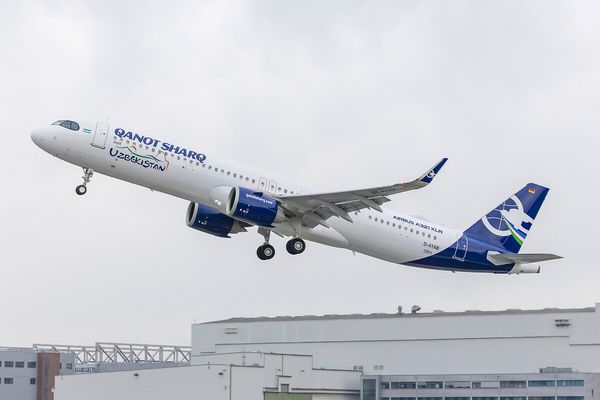As turbojet engines are effective from zero speeds, they are employed to propel aircraft from stationary to very high speeds and provide the necessary thrust for takeoff from a runway. A turbojet engine's top speed is roughly Mach 3.5 depending on the model, and thus it is not capable of operating in the hypersonic regime.
As an airplane's forward velocity exceeds Mach 1.0, the air pressure generated by the speed of the airflow through the core reduces the need for a compressor. When speeds approach Mach 3.5-4.0, a compressor is no longer required. Based on this phenomenon, the ramjet was invented and patented in 1908 by the French scientist René Lorin.

The ramjet is a jet engine without a compressor or a turbine. It is essentially a tube through which air enters purely as a result of the plane's forward motion. At the inlet, the air hits a diffuser to create high static pressure for combustion and is slowed to subsonic speeds. Fuel is supplied and the fuel-air mixture is burned. The heated gases that result are ejected at the opposite end through the exhaust nozzle. Ramjets by definition need ram air, that is to say, air that is forced into the intake as a result of the aircraft's high speed, thus they are redundant at zero speeds. Consequently, a reasonable starting point for this engine to work is at approximately Mach 3, and they can sustain effective propulsion as fast as Mach 6.
Ramjets are very helpful in applications featuring a small, focused, and straightforward mechanism for high-speed operation, such as missiles.
The acronym Scramjet stands for Supersonic Combustion Ramjet. It is distinguished from the ramjet by the fact that combustion occurs at supersonic air velocity inside the engine. This enables the scramjet to attain higher speeds than a traditional ramjet which has to reduce the incoming air to subsonic speeds before it enters the combustion chamber. Since the scramjet does not have to decelerate the air as much, the temperatures are much more tolerable for the engine parts and materials.

Scramjet engines can then operate at speeds of around Mach 6 and above. Although scientists are unsure of a scramjet's highest Mach number limit, certain experimental scramjets have flown under Mach 10 circumstances. They are perfect for hypersonic flying at flight levels much higher than turbine engines are able to withstand.
Alaska Airlines Defends Home Turf with 7 Strategic New Routes for 2026 » Air Canada Rouge to Launch Boeing 737 MAX 8 Operations » Engine Failure Forces United 777 Emergency Landing, Starts Brush Fire at Dulles Airport »
Comments (1)
 Ramkumar
Can the Ramjet / Scram jet be downsized to the level to introduce High Speed / bullet trains. The likely benefits required: 1. Reduce the fossil fuel consumption. 2. High Speed transport from point to point 3. Air drop Pay loads may be by para / drones for various applications civil, Medical, Military, Space applications
Ramkumar
Can the Ramjet / Scram jet be downsized to the level to introduce High Speed / bullet trains. The likely benefits required: 1. Reduce the fossil fuel consumption. 2. High Speed transport from point to point 3. Air drop Pay loads may be by para / drones for various applications civil, Medical, Military, Space applications
Add Your Comment
SHARE
TAGS
INFORMATIONAL supersonic ramjet scramjet informational missiles jet turbojet turbineRECENTLY PUBLISHED
 Air Canada Rouge to Launch Boeing 737 MAX 8 Operations
Air Canada has officially confirmed a strategic shift for its leisure subsidiary, Air Canada Rouge, announcing that Boeing 737-8 (MAX 8) operations are slated to begin in late Q1 2026. The move marks the beginning of an ambitious year-long transition that will see Rouge evolve into an all-Boeing 737 operator.
ROUTES
READ MORE »
Air Canada Rouge to Launch Boeing 737 MAX 8 Operations
Air Canada has officially confirmed a strategic shift for its leisure subsidiary, Air Canada Rouge, announcing that Boeing 737-8 (MAX 8) operations are slated to begin in late Q1 2026. The move marks the beginning of an ambitious year-long transition that will see Rouge evolve into an all-Boeing 737 operator.
ROUTES
READ MORE »
 Qanot Sharq Takes Delivery of First Airbus A321XLR to Transform Central Asian Long Haul Travel
Uzbekistan’s premier private carrier, Qanot Sharq, has officially taken delivery of its first Airbus A321XLR. The delivery, which took place today at the Airbus facility in Hamburg, makes Qanot Sharq the launch operator for the ultra-long-range narrow-body in the Commonwealth of Independent States (CIS) and Central Asia.
ROUTES
READ MORE »
Qanot Sharq Takes Delivery of First Airbus A321XLR to Transform Central Asian Long Haul Travel
Uzbekistan’s premier private carrier, Qanot Sharq, has officially taken delivery of its first Airbus A321XLR. The delivery, which took place today at the Airbus facility in Hamburg, makes Qanot Sharq the launch operator for the ultra-long-range narrow-body in the Commonwealth of Independent States (CIS) and Central Asia.
ROUTES
READ MORE »
 Citation C550 Fireball: Greg Biffle and Five Others Killed in Failed Emergency Landing at KSVH
The aviation community and the world of motorsports are in mourning today, December 18, 2025, following a catastrophic accident at Statesville Regional Airport (KSVH). A Cessna Citation II (C550), linked to retired NASCAR star Greg Biffle, crashed while attempting an emergency landing shortly after takeoff, claiming the lives of all six people on board.
NEWS
READ MORE »
Citation C550 Fireball: Greg Biffle and Five Others Killed in Failed Emergency Landing at KSVH
The aviation community and the world of motorsports are in mourning today, December 18, 2025, following a catastrophic accident at Statesville Regional Airport (KSVH). A Cessna Citation II (C550), linked to retired NASCAR star Greg Biffle, crashed while attempting an emergency landing shortly after takeoff, claiming the lives of all six people on board.
NEWS
READ MORE »



